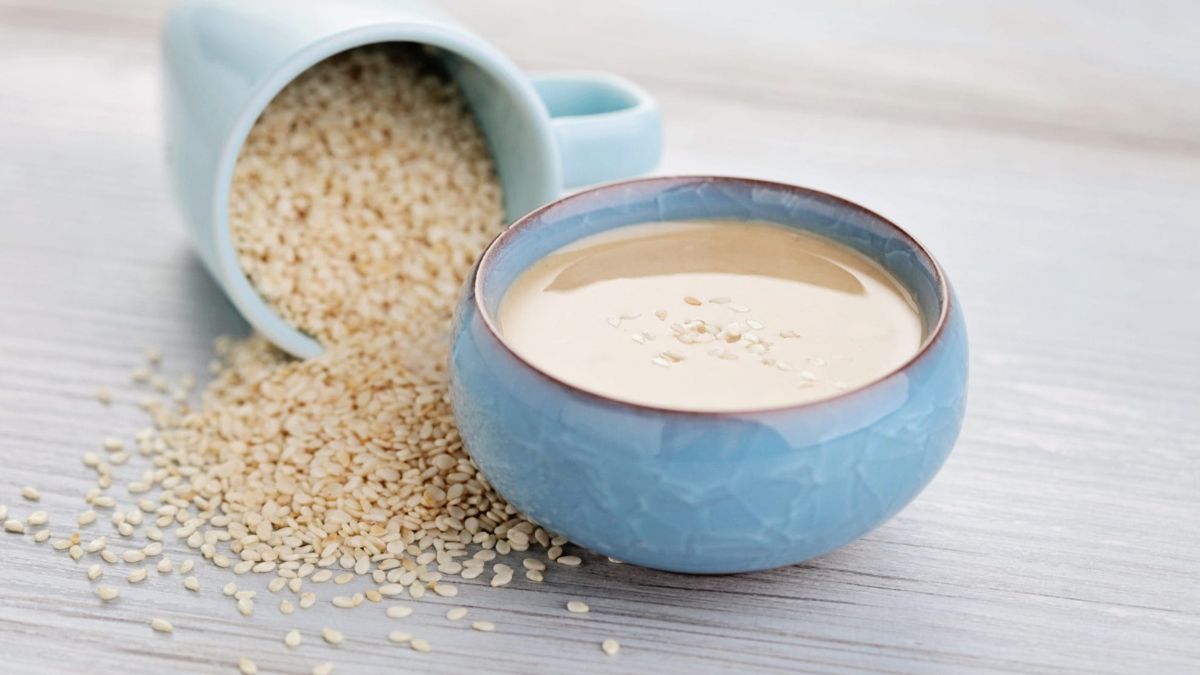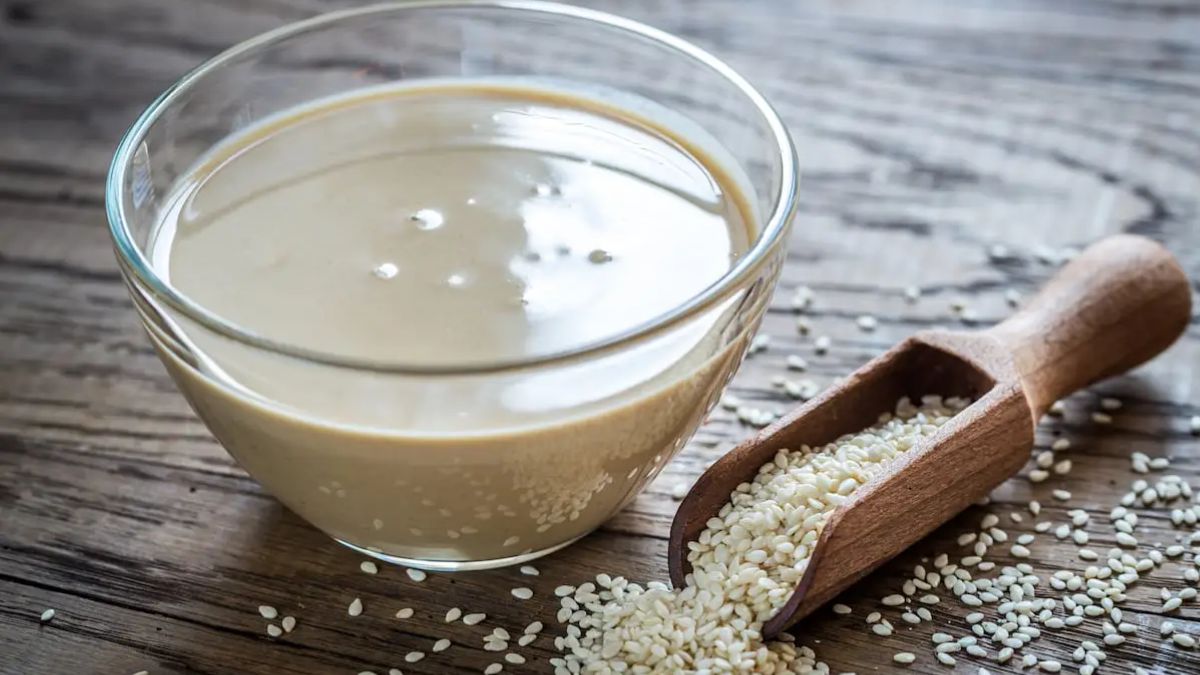Tahini, also called “tahina” in some places, is used a lot in the Mediterranean and Middle East food. Tahini paste is made by grinding sesame seeds into a paste, and it is often seen in classic dips like hummus and baba ghanoush. Sauces with it tahini are common in Armenian, Turkish, Iraqi, Cypriot, Greek, East Asian, and Indian food and chefs all over the world know how versatile this simple but tasty and healthy ingredient can be.
Tahini is a paste made from sesame seeds that have been toasted and ground. Tahini is a common ingredient in traditional Asian, Middle Eastern, and African dishes and is also in Mediterranean cooking. It is a very flexible ingredient used as a dip, spread, or topping. It usually has a smooth texture like nut butter, but a stronger, savory taste is often described as bitter. In addition to being full of nutrients, tahini has been linked to some health benefits, such as better heart health, less inflammation, and possibly even fighting cancer.
What is Tahini?
How to Make Tahini Recipe?
A Middle Eastern pantry essential, tahini is the foundation for many Middle Eastern recipes, including baba ganoush and, most notably, hummus—though its uses extend far beyond just those two common recipes. Although you can buy pre-made tahini at some grocery stores (though, in some areas, you might have to visit a Middle Eastern grocer), it can be pricey. Additionally, j red tahini doesn’t always taste as good because it’s been sitting on the shelf for a long time. It might taste bitter, astringent, or even slightly acidic and have a chalky mouthfeel. On the other hand, good tahini tastes slightly nutty, savory and has a creamy texture.
Luckily, tahini is incredibly easy to make at home. Additionally, you can find sesame seeds in bulk bins, often at international markets or natural foods stores, making your tahini inexpensive. If the grocer h s various types of sesame seeds (hulled, unhulled, sprouted, toasted, etc.), try out a variety of them for different flavors, colors, and textures in your tahini. The process of lending the seeds will take just five minutes, and then you can use this homemade tahini in your hummus recipe or whip up a tahini-based sauce for a Middle Eastern dish.
Ingredients
- 5 cups sesame seeds
- 1 1/2 cups olive oil or vegetable oil
- Salt, to taste
Steps to Make it
- Set the oven temperature to 350 F. Toast the sesame seeds for 5 to 10 minutes, often turning them with a spatula. Don’t let it burn or turn brown. Take the seeds out of the oven and give them 20 minutes to cool down. You can also st the seeds over medium heat in a dry skillet. Stir the seeds for about 5 minutes until they are light brown but not brown.
- Transfer the toasted seeds to a tray and let them cool completely.
-
Fill the food processor with sesame seeds. While the food processor is running, slowly pour in the oil. Blend for 2 min. Make sure everything fits. The goal is for it to be thick but still easy to pour. Add more oil and blend until you get the texture you want.
-
Add salt to taste.
Is Tahini Vegan?
What is a Good Substitute for Tahini?
Popular Substitutes
Since tahini is made from sesame seed butter, you might want to use nut or seed butter instead. Greek yogurt a d sesame oil are two other choices. These alternate es to tahini will go well with your dish because they are all good sources of healthy fats and help make it creamy.
Cashew Butter
People often say peanut butter can be used instead of tahini, but cashew butter may work better. It is a more ne tral nut butter that is often used like tahini as a base for plant-based dips, sauces, and salad dressings.
People who are allergic to sesame seeds can eat cashew butter instead. But it does not go d for people who are allergic to nuts. In terms of nut ition, cashew butter has a few more calories and carbs. But it has less fat and more protein than the other one. You can use the same amount of cashew butter instead.
Almond Butter
Almond butter is one of the most popular nut butter. Because it has more fiber and micronutrients than peanut butter, it can also be used instead of tahini because it is smooth, full of healthy fats, and has a mild taste. People with nut allergies can’t use almond butter instead of tahini, but people with sesame allergies might be able to.
Regarding nutrition, almond butter and tahini are not that different from each other. Almond butter h s a few more calories and fat than peanut butter, but it has fewer carbs and more protein. Almond butter c n be used in the same amount as peanut butter.
Sunflower Butter
Try sunflower butter if you want an ingredient that tastes a lot like tahini. Sunflower butter and tahini are both made from seeds, but sunflower butter is usually thicker than tahini. Sunflower butter has more calories, fat, and carbs, but it also has more protein than peanut butter. You can use sun lower butter in place of tahini in recipes in the same amount.
Remember that if your sunflower butter brand has added sugar, it might not taste the same, especially in savory dishes. You can make it yourself with sunflower seeds and sesame oil, or you can look for one that doesn’t have sugar in it.
Greek Yogurt
Many people choose Greek yogurt because of how healthy it is. This high-protein n food is easy to use and full of nutrients, so it is often used as a substitute for tahini and other ingredients. It also works v very well in place of tahini in dips and sauces, which are thinner because it has a similar flavor. Because Greek y gurt and tahini have different textures, you may need to change how much of each ingredient you use. Greek yogurt is better for you because it has more protein and less fat. It also has few r calories than tahini. It has more sugar and less fiber than tahini, though.
Store-bought tahini that hasn’t been opened can be kept in a cool, dry place, like a cupboard or pantry, away from direct sunlight and heat sources. Check the label to see when it will be best to sell. Store-bought t ini that has been opened can be kept in the fridge or a cool, dry place away from direct sunlight and heat sources. If you’re not s re how to store something, look at the label. If the tahini s sells or tastes rancid or “off,” it is no longer good. If you use tahi I often and plan to use it within a month, you can store opened containers of tahini in a cool, dry place away from heat and sunlight.
Refrigerating tahini will make it last longer. If you don’t pl n to use the whole jar within a few weeks of opening it, it’s best to put it in the fridge, which will last for up to 6 months. Also, homemade tahini should be kept in the fridge in a jar with a lid or an airtight food storage container, which will keep in the fridge for up to a month. If the solids a d oil separate, stir them back together. Also, keep in m nd that tahini that has been kept in the fridge might turn into a paste-like texture. Just let it come to room temperature before using.
Fans of tahini don’t agree on the best way to store it. Some say the pa try is fine, while others say the fridge is best. If you eat it q quickly, within a few months, you should be fine keeping it at room temperature. However, it could go not good, not good, cause it has a lot of oil. If it does, you should know because it will smell sharp or metallic and taste bad. Like natural pe nut butter, the oil in a jar of tahini separates, and it can be hard to mix it back together after it has been in the fridge for a while, even though the cold makes it last about six months longer. Before trying it, you may need to warm it up in the microwave or a bowl of warm water.
How to Use Tahini?
Good tahini can be eaten right out of the jar, but it might be the main ingredient in hummus or, for the more adventurous, drizzled over fruit, mixed into cheesecake, or used as a marinade for chicken or lamb.
In Israel, locals and tourists like to put herb-flavored tahini sauce on falafel-filled pitas. It’s also a popular way to top vegetables and sometimes even fries. You can add it o soup to make it creamy without using dairy, thicken a smoothie with it, or just spread it on toast. Or, make vers tile tahini sauce by mixing it with lemon juice, olive oil, and seasonings to make a spread for sandwiches, a marinade for meat, or a simple dip for vegetables.

